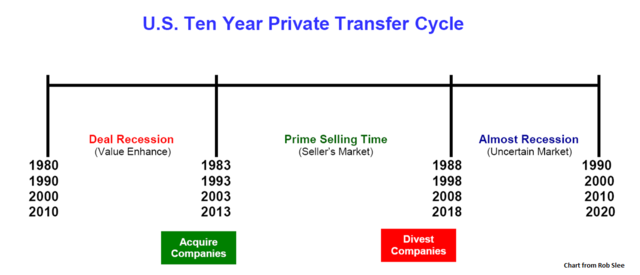It has been said that ‘timing is everything’. Well in business transition planning, timing is important, but so is transferability. Today’s newsletter discusses both and is intended to provide you with some guidance as to how you can begin to design a plan for a successful business transition, which includes growing the transferable value of your business towards an exit that is a number of years into the future.
Gaining an Exit Perspective
Setting a plan for an exit requires a perspective on what you are trying to achieve and when it is possible to attain such an outcome. An important consideration for every business owner is that of ‘exit windows’, or, how to time your exit to meet your business and personal goals. Once you understand the timing of your exit, there is an opportunity for you to begin planning and making decisions today based upon achieving this future exit. Without this type of planning, you are likely to be without direction for your exit, and possibly missing the next exit window.
Exit Windows
The chart below illustrates the cycle of business exits and shows that the next likely window for exit is within the next few years. According to this ‘ten year transfer cycle’ chart, in 2015 we are inside of a window for exit that may last for another three (3) years or so – see below

–Rob Slee, Private Capital Markets
So, how can you grow into your exit? Well, you can begin with the end in mind. You can begin by understanding when you would like to exit and then build the business around that timing.
Three Concepts Relating to a Transferable Business
In order to manage anything in life and in business, you need to be able to measure it. A measurement of your current value becomes very important. A plan to grow that value as you approach your exit becomes a critical part of the exit planning process. There are three (3) concepts that you should be looking at when thinking about growing into your exit. They are:
1. Profitability
2. Sustainability
3. Transferability
We take these three (3) critical concepts in order to help you further analyze your opportunity for a successful exit.
- Profitability
The profitability of your business is best understood as ‘the cash flows that would be available to somebody other than you who was to own your business in the future.’ Profitability is critical to your exit because any future owner of your business – be it a buyer from your industry or your management team, or another party – will want to know what they can expect as a return from owning your business. Since all businesses are valued based upon the expectation of future cash flow, you need to look ahead to understand where and how profitability will be generated and to make the best projections possible, i.e. the projections that show the lowest level of risk.
- Sustainability
The second element to a successful business exit is sustainability – i.e. will my future owner be able to continue to generate profits in my company without me being here? This is the challenge in today’s marketplace for the small business owner. Sustainability of your profits extends beyond simply generating cash flow. You also need to take steps to assure that your next owner will be confident that the profits will continue. The simple task of managing your business with systems and controls that are run by someone other than you is a good first step. By doing this, you increase the ‘sustainability’ of your profits. And, by understanding how to sustain the profits in your business, you can look to grow into your exit.
- Transferability
The last component of growing into your exit is the transferability of those profits. Many businesses that are owned and operated by the primary business owner are non-transferable because when that owner becomes detached from the business, the business ceases to operate as it currently does. By focusing on the transferability of your business, you will help ensure that management and the employees are capable of running the business, that systems and processes are well developed, that the brand is independent of the owner, that the customer will survive the owner’s exit, and that the business model is supportable without the owner. All of these issues can, and should, be addressed in today’s market environment for the owner who wants to exit during the next window of opportunity.
Concluding Thoughts
In conclusion, if you know that your exit window is a few years away, it is important for you to begin planning today. You will want to run your business with your exit in mind, focusing on its profitability, sustainability, and transferability. In this way, you can increase the likelihood of meeting your exit goals, which have been measured as a part of your total exit and business transition planning.
BERI™ Report
Below is a link to a 10 minute, 20 question online assessment that can assist you in determining your financial and mental readiness for your exit. There is no fee to take the assessment and your answers are sent immediately to your e-mail and kept completely confidential.
Business Exit Readiness Index™ Owner’s report
As a business owner who may be thinking through the eventual exit from their business, this complimentary online assessment may be the ideal starting point. And, after receiving your Business Exit Readiness Index™ Owner’s report, you may want to take a follow up meeting to discuss your answers further and gain more clarity on how you will have a successful exit in the future.







